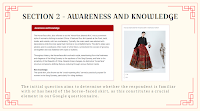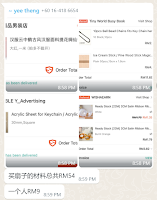5.2.2024 - 29.3.2024 ( Week 1- Week 7)
Gam Jze Shin / 0353154
Intercultural Design / Bachelor of Design in Creative Media
Final Compilation & Reflection
Index
Instructions
Project 1: Proposal
In this module, groups should consist of no more than 6 members. Additionally, the lecturer specified that no more than three members should be from the same semester intake. To form our groups, we utilized different colored stickers during physical classes in lecture theatre one. For Project 1, we were tasked with creating a proposal that solidifies ideas supported by research. This proposal should focus on a final design centered around a given theme, showcasing students' comprehension and interpretation of global issues and design aesthetics.
- The general theme is “Cultural Sensitivity in Design”.
- You are to study a cultural phenomenon, or a particular subculture that is perceived as ‘sensitive’, and “frame” your study within the chosen theme.
- You are to convey this cultural aspect without altering the actual facts but within a presentable interpretation and adaptation that raises awareness from the viewers.
- Produce some preliminary ideas on how to visually express your interpretation using design language. Each idea is to be supported by a short rationale. Conduct visual research to help expand your idea generation.
Progress
In second week, our group was formed, and my fellow group members are:
- Nicole Yeow Zhi Ying 0370289 (Leader)
- Gam Jze Shin 0353154
- Liew Xiao Hui 0353121
- Tan Jie Ying 0353959
- Phang Yee Theng 0372664
- Sima Heshu 0368451
fig 1.2 WhatsApp group
Then, we established a group on WhatsApp for our convenience, as it provided a convenient platform for discussing our project.
During our first Google Meet session, we collectively decided on our theme: the traditional costume known as the Horse-face skirt. This idea stemmed from the recent widely-discussed Dior case, highlighting the cultural sensitivity surrounding traditional and contemporary fashion. Our primary objective is to delve deeper into this overarching theme, aiming to raise awareness among the public.
fig 1.4 Research before doing proposal
Before drafting the proposal, each of us conducted individual research online. We compiled relevant information and data, which we then listed on Canva slides for our proposal. This approach streamlined our process, saving time, and allowing for diverse perspectives and ideas from each team member.
Project 2: Field Study
The second project involves conducting a data gathering collection process about culture relevant to the theme, research objectives, issues, and design aesthetics.
The students are required to collect visual, oral, textual and tactile artefacts that would be part of their research materials for the ideation in Project 1 (proposal). All collected artefacts and materials must be recorded, kept and documented, accompanied by necessary information such as the type of artefact and material, its purpose, its symbolism, its cultural/historical background, and more, depending on the kind of artefact and material.
Data Collection Methods
Some of the methods by which you can collect data:
- Observation study.
- Interview of relevant stakeholders (from the lecture series, you may approach any of the guest speakers for an interview, if you deem their presentation useful for further research).
- Online and/or actual physical material* visual research of the selected culture (the people/arts/symbols/architecture/text/calligraphy etc.)
We decided to collect the data via four different methods which is observations, survey (Google Questionnaire), Interview (Online) and online materials.
Final Project: Design Outcomes
In this final project, upon the completion of the research, data collection, participation in all class lectures and tutorials, presentation of a complete proposal and research data, students are to produce visual design outcomes related to their interpretation of the given theme.
Requirement:
Utilising the data collected from the research trip, students are to produce visual design outcomes that reflect their interpretation and definition of “Framing”, bearing in mind to consider cultural and aesthetic aspects, balanced with their design knowledge. Various directions and approaches can be engaged in, such as experimental design/art with the use of manual/digital or combination of both media.
Progress
In week 5, we conducted a meeting to discuss on our final visual design outcome. After thorough discussion, we collectively agreed that creating a booklet might be too simplistic. Consequently, we opted to design a handmade folding fan instead. This fan would feature a QR code linking to our website, which contains comprehensive information about the Horse-face skirt.
Handmade Folding Fan
We also deliberated on the choice of fabric for the Horse-face skirt, considering its suitability for the final outcome. Eventually, we opted for red fabric, as this color represents good luck and auspiciousness.
Website
For the website part, Xiao Hui, Jie Ying, and I will be in charge of it. Initially, we brainstormed our ideas regarding the website's style, layout, color scheme, and font. After thorough discussion, we concluded that we would combine our ideas, drawing inspiration from fashion layouts while incorporating Chinese elements. The color scheme will consist of red, black, and white, and we decided to use the Philosopher font.
fig 3.10 Websites sketches draft 1
fig 3.11 Websites sketches draft 2
Xiao Hui created the layout draft for the website, and we presented it to our assigned lecturer during our physical class.
This is the slide that contain all of the information we would like to place into our website. There are 5 parts which is history, design, symbolism, craftmanship and styling.
I completed the entire website design layout using Wix. Additionally, I utilized the blog function to publish all the posts and integrated them into the relevant pages.
We print the Qr code out and incorporate it into the fan for physical submission.
Final Design Outcomes
Feedback
Week 4
Specific Feedback: The lecturers approved our chosen topic, Horse-face
skirt, and informed us that we can now proceed with
completing the data collection stage.
Week 5
Specific Feedback: Our group's assigned
lecturer, Ms. Noranis, noted that
topics related to Horse-face
skirts are relatively new in the
fashion world. She suggested that
we prioritize completing the data
collection stage first. Once we
have gathered sufficient data, we
can then draw conclusions
supported by rationale. Following
this, we can proceed to design the
visual outcomes.
Week 6
Specific Feedback: During the Week 6
physical class, we presented our
sketches of the visual design
outcome. Ms. Noranis commented
that the concept is neat and the
website layout design looks
good. She expressed that we seem
to have a clear direction for
the outcome. Additionally, she
suggested the idea of finding
individuals around us who are
enthusiasts of Horse-face skirts
and including videos of them
wearing it in real life on our
website.
Reflections
Experience
In this module, I am satisfied with the
outcome we have achieved. First and
foremost, I would like to express my
appreciation to my group members for their
dedicated effort throughout the journey.
Each member contributed significantly, and
our shared goal helped keep us aligned.
While we initially felt uncertain about
what we needed to do, we remained
committed to conducting research, which
gradually provided us with more clarity
and direction. Exploring the concept of
cultural sensitivity in design was a new
experience for me, and I found it
challenging yet refreshing. Despite the
limited real-life examples available
online on this theme, we persevered and
embraced the opportunity to delve into
something novel.
Observations
From this module, I observed that in our
daily lives, we may not always be conscious
of cultural sensitivity until it becomes
apparent when something deviates from what
we consider normal. During such instances,
cultural insensitivity can arise, leading to
a sense of offense towards our culture. It's
crucial to recognize that cultural
sensitivity is a serious matter, as it
impacts how individuals perceive and
interact with various designs.
Unfortunately, many designs worldwide lack
cultural sensitivity, often due to
manufacturers prioritizing commercial
interests over cultural considerations. This
oversight can result in misunderstandings
among audiences or dissatisfaction among
users.
Findings
Through the process of completing
this module, I applied
discipline-specific knowledge and
skills by deepening my understanding
of my specific theme, which is the
Horse-face skirt. This was essential
for presenting accurate and
comprehensive outcomes to others.
Additionally, my thinking and
problem-solving skills improved as I
needed to think creatively to address
cultural sensitivity issues prevalent
today. It was a challenging journey
that required hard work, but I believe
that perseverance and incremental
research efforts will eventually lead
to solutions.
.jpg)





































.png)


Comments
Post a Comment